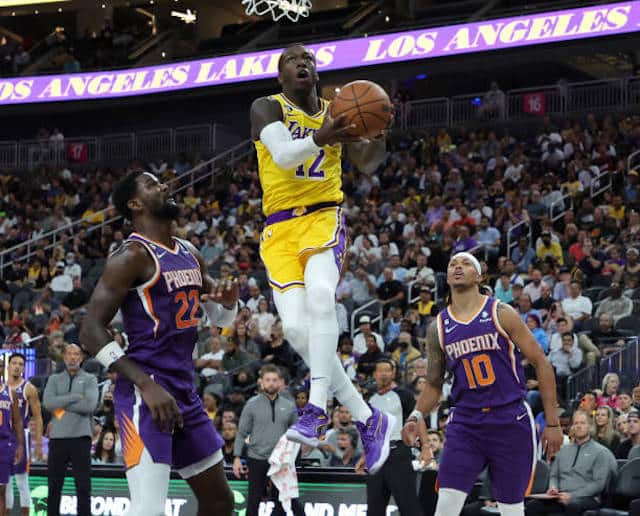Los Angeles Lakers guard Kendrick Nunn is having an impressive preseason, showing very little rust after missing the entire 2021-22 campaign with a bruised knee.
In two preseason games, Nunn is averaging 17 points per game, shooting 52.9% from downtown on more than five attempts a night. The 27-year-old looks to be a lock-on candidate to feature in L.A.’s starting lineup besides LeBron James, Anthony Davis and Russell Westbrook at the start of the season — and could prove to be one of the major roster reinforcements if he keeps up his form.
A lot of work went into Nunn’s long-awaited comeback. The former Miami Heat standout partnered with Athletix Rehab and Recovery over the summer to make sure he can return to the court safely and become a reliable weapon for the Lakers in 2022-23.
Many athletes have used the South Florida recovery clinic’s services in the past, including NBA players Cameron Johnson, Will Barton and Michael Beasley. Even more NFL stars have turned to Athletix for help, including CeeDee Lamb, Leonard Fournette and Alvin Kamara.
The New Orleans Saints running back has trained with the clinic’s co-owner, Dr. Sharif Tabbah, for years. Tabbah, a doctor of physical therapy and certified strength and conditioning specialist, says he and Nunn connected on Instagram in July 2022. The Lakers guard’s bone bruise was “pretty old” when he started his three-week program at Athletix later in the summer, Tabbah adds.
“When he came to me, he still had some discomfort and things like that, but pain wasn’t the massive issue anymore,” Tabbah says. “It was really about, ‘Okay, I need to get back to getting comfortable, getting back to ball’ at this point.”
Tabbah explains that a comeback from a bone bruise could be a challenge for NBA players. Unlike in football, there’s no grass that can absorb force going through the bone upon landing on the hardwood. The extra force only amplifies the impact of thermogenic inhibition, Tabbah explains, which is a body’s protective response to pain that shuts down the muscles. As a result, less force goes to the muscles and more force goes to the injured bone, causing the bruise to hurt even more in a vicious circle for the recovery process.
Tabbah used a direct current electrical stimulation machine to override this reaction, particularly in the early stages of Nunn’s program. Attached to the Lakers guard’s quad, electrical impulses forced muscle fibers to contract, absorbing more force and helping the whole knee joint improve its performance.
That was just a part of Nunn’s daily two-and-a-half-hour session, aiming to aid his body deal with the dynamic movements that are an intrinsic part of the game of basketball. “The more we can teach him to absorb that force with his quads, his glutes, these other muscles that are contractile — that can load, stretch, absorb that force and then contract again to reproduce the force — the less force will actually go to the bone and the bone bruise itself,” Tabbah says.
From Monday to Friday, Nunn would go through 30 minutes of massage, manual therapy, cupping and other treatments that are designed to increase tissue and joint mobility, improve blood flow and promote healing.
Next, the guard would do another half-hour of warm-up, including knee extensions, hip exercises and balancing activities. Then, Nunn would start an hour-long performance workout, consisting of different types of lower body strength drills and multi-directional movements.
View this post on Instagram
After Nunn’s body got strong enough to tolerate conventional strength exercises and deal with force absorption well, Tabbah added agility and hand-eye coordination components into the program by incorporating BlazePod into the drills — a set of multi-colored lights the guard had to tap in a certain order as the pods changed their colors in an unpredictable pattern.
Tabbah used BlazePod for more stationary exercises, like balancing on a Bosu half ball, as well as movement drills such as lateral shuffle between cones.
“It’s about being able to challenge his body and his leg, and his mind in a way that’s not so predictive and it’s a little more stimulatory of being on the court,” Tabbah explains. “You can’t simulate that immediate reactiveness in other ways. That’s what the lights do such a good job of.”
Eventually, Tabbah added tennis balls to the shuffle drills, tossing them with Nunn back and forth as the guard moved around to stimulate his reactive agility. Eventually, the trainer switched the tennis balls for an actual basketball, making Nunn look for the right light and shuffle between cones while also anticipating the possibility of a random basketball pass heading his direction.
“Now we’re just stacking layers of movement with cognition, with decision-making, which really does a good job of representing play on the court,” Tabbah says.
“If you’re playing defense, I’m reading what my guy’s doing. I’m trying to read what was happening on the rest of the court. I got to keep my head on a swivel so I can maybe intercept a ball or make a block, or get off my guy to make another defensive slide. Different things like that.
“How can we simulate that in training and in rehab? These little tricks help.”
View this post on Instagram
View this post on Instagram
By creating a simulation of a basketball game-like environment, Nunn could get his body accustomed to the stress that his body would be under during an actual game again. “It’s easy to say, ‘Okay, yeah, my knee feels good,” Tabbah says of traditional drills.
“But what happens when there’s a ball flying over your head, and you got to open your hips one direction to go get to the light but the ball goes this way? Once you have to put your foot on the ground and come back, that’s going to stress the body in a lot more realistic way.
“But of course, you got to progress to that point.”
Tabbah says athletes sometimes miss crucial stages of rehabilitation once they are cleared by a surgeon to play basketball but they are still in the early stages of regaining optimal conditioning. Tabbah says what sets Athletix apart is the fact their doctors of physical therapy are also certified strength and conditioning specialists, making them qualified to guide an athlete through the entire recovery process.
“We really are blending our knowledge of rehab and medicine with our understanding of performance and what is required,” Tabbah says.
Although Tabbah wishes he had more than three weeks to work with Nunn, he says the guard was feeling confident going back to the team ahead of the start of training camp.
“He left in a good place mentally,” Tabbah says.
“He’s a ton of fun to work with,” he adds. “He really comes and gets his work in. And it was fun to see him progress. I’m glad we had a pretty smooth sailing experience. No setbacks and he did really, really well. He was pretty out of pain for the most part pretty quickly.”






